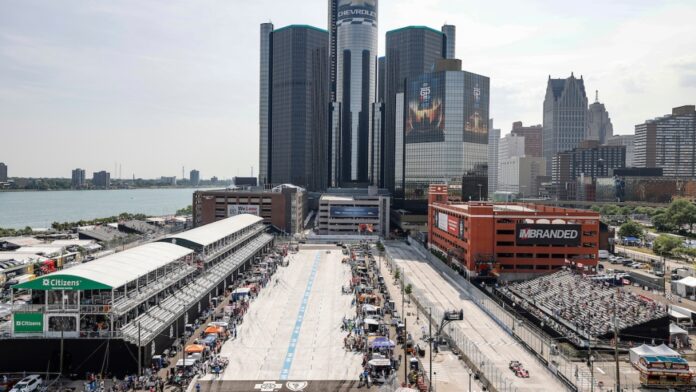The NTT IndyCar Series teams and drivers have only had a single 90-minute practice session to get to know the new downtown Detroit street circuit so far, but early impressions are that it’s unlike any other venue on the calendar.
Short, narrow and bumpy, the track already promised to be one of the most challenging for passing or trying to find a clear piece of road during qualifying. But one of the big question marks is how the unique split pitlane will factor into the race.
“When the sessions started, there were quite a lot of cars coming in, four-wide, into the funneling section,” said Arrow McLaren’s Felix Rosenqvist, who was fifth-fastest on Friday.
“It’s kind of unique in that way because the pit speed limit off section is way further, like after the funnel. We’re going to have to figure out who’s going first in there. I think there’s going to be some situations where people probably don’t want to lift.
“I mean, that’s kind of what IndyCar is, that we battle it out on track. I think that’s pretty cool. Let’s hope it doesn’t crash us in pit lane.”
Andretti Autosport’s Kyle Kirkwood, who finished Friday’s session one place ahead of Rosenqvist, had no concerns about pitlane itself, but believes drivers will need to tread carefully when rejoining the track.
“In my mind, (pitlane is) very safe,” he said. “That’s the most important part. It seems like pit exit was a concern for everyone yesterday, but it doesn’t seem like it’s going to be that big of an issue. I think everyone’s pretty calm though on exit. It’s pretty easy to see a car coming out.
“To be honest, you can’t really see the car that’s on track, so you’re very reliant on the car that’s on track to kind of give way, for you to just kind of stay out of the way. That was more the concern than the double pit lane. I think the double pit lane has been absolutely fine.”
The other takeaway from Friday’s session was that the new layout will give the teams’ damper programs a chance to shine.
“You’re not using the wings of the car really here,” said Rosenqvist. “It’s a very mechanical grip track. Pretty much every corner is first gear except for the one leading onto the back straight. The car is always doing something weird. It’s dancing around, bouncing around, and at the same time you’re trying to keep it off the wall. It’s busy from the driver’s standpoint. It’s probably going to catch people out in the race.
“I think this track is probably the most important in terms of damping. That’s pretty much the biggest tool we have to work with mechanical grip. I don’t think I’ve even talked about aero today with my engineer — front wing, anything like that — because there’s only one corner where you really feel it.
“It’s a different challenge. These cars have quite a lot of downforce. Normally there’s a lot of emphasis on making the things efficient with downforce and drag and such things. But here it’s just like the more mechanical grip, the better. It’s kind of back to go-kart days in that sense.”
Presented by:




